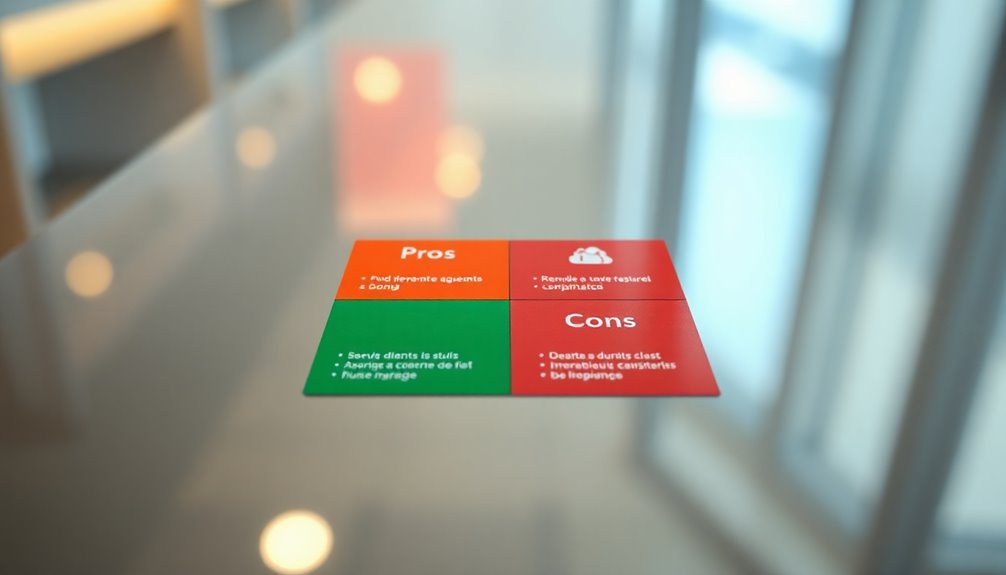Qt's a powerful framework that lets you create cross-platform applications effortlessly. You can build both GUI and non-GUI applications, making it versatile for different projects. Its modular architecture optimizes performance and allows for internationalization. With the signal and slot mechanism, you can implement event-driven programming, enhancing the communication between components. You'll find that Qt supports major operating systems, including Windows, macOS, and Linux. While it offers a native look and feel, getting started can be challenging, especially if you're new to C++. There's much more to explore about its capabilities and features waiting for you.
Key Takeaways
- Qt is a cross-platform application development framework that supports both GUI and non-GUI applications across major operating systems like Linux, Windows, and macOS.
- Qt Core provides essential non-GUI classes, enabling functionalities like event handling and file I/O.
- The signal and slot mechanism in Qt facilitates event-driven programming, allowing seamless communication between objects.
- Qt Quick enables rapid development using QML and JavaScript, enhancing user interface design and interactivity.
- The framework features a modular architecture that supports internationalization, enhancing app performance and usability across different languages and regions.
Core Framework Overview

The Qt framework serves as a powerful tool for developers looking to create cross-platform applications. At the heart of this cross-platform application development framework lies Qt Core, which provides essential classes for non-GUI functionalities like event handling and file I/O.
This module is crucial for building robust applications across various operating systems, including Linux, Windows, and macOS. With Qt's signal and slot mechanism, you can implement the observer design pattern, enabling seamless communication between objects.
While C++ is the primary programming language used, Qt also supports multiple languages through bindings. Additionally, its extensive library includes multimedia capabilities, making it ideal for a wide range of applications, from desktop software to embedded systems.
Overview of Qt's Capabilities

Qt offers a rich set of capabilities that cater to a wide range of application development needs.
With its cross-platform development features, you can create applications using Qt that run seamlessly on Linux, Windows, and macOS.
The Qt Framework supports both graphical user interfaces and non-GUI applications, enabling you to build everything from desktop software to command-line tools.
For dynamic interfaces, you'll find Qt Quick, which incorporates QML and JavaScript, allowing for rapid application development.
Additionally, you can utilize Qt Designer to craft user-friendly layouts effortlessly.
The modular architecture of Qt lets you select only the necessary modules, optimizing performance while supporting internationalization and localization through tools like Qt Linguist, making your applications adaptable for diverse users.
Signal and Slot Mechanism

In application development, understanding the signal and slot mechanism is crucial for effective communication between objects. This core feature in Qt implements the observer pattern, enabling event-driven programming.
When an event occurs, objects emit signals, and these signals are connected to slots—functions that respond to the signals. This setup allows for loose coupling, meaning components can interact without direct dependencies.
The mechanism is type-safe, ensuring signals and slots have compatible signatures, so the right data types are passed during communication. Qt's Meta-Object Compiler (moc) processes these declarations, generating the necessary code for runtime connection management.
With options for direct, queued, and auto connections, you gain flexibility in how signals and slots interact across different threads.
Pros and Cons Summary

While many developers appreciate Qt for its robust capabilities and cross-platform support, it's important to weigh both its advantages and drawbacks.
On the plus side, Qt's framework allows you to create applications with a native look and feel across major operating systems, enhancing user interface consistency. Its modular architecture and internationalization support make it flexible for diverse software development needs.
However, licensing complexities can pose challenges, especially if you require compliance with GPL for commercial applications. Additionally, newcomers might find the learning curve steep, particularly with C++ and the signals and slots concept.
Lastly, while Qt is powerful, its performance may lag behind frameworks specifically optimized for high-performance applications, which could affect your development choices. Furthermore, understanding the decentralized nature of software frameworks can also influence your decision-making process.
Cross-Platform vs. Native Development

Choosing between cross-platform and native development can significantly impact your project's success.
With Qt, you can embrace cross-platform development, writing your code once and deploying it across Linux, Windows, and macOS seamlessly. Qt's unified API simplifies this process, maintaining a consistent look and feel across different platforms.
Its modular architecture lets you select only the components you need, optimizing performance and reducing application size compared to native solutions. Plus, the signal and slot mechanism enhances communication between objects, making event handling uniform across environments.
With support for QML and Qt Quick, you can rapidly create dynamic user interfaces that adapt to various screen sizes, ensuring a smooth user experience on diverse devices. Furthermore, understanding the Software Development Life Cycle (SDLC)(https://example.com) is crucial as it helps identify where quality assurance fits in the development process.
Integration Complexity Issues

Integrating Qt into existing legacy systems can be tricky, as differing architectures and APIs often require careful planning and adaptation.
While Qt's modular architecture allows you to use specific components, it can complicate dependency management and version compatibility across modules.
The introduction of the Meta-Object Compiler (moc) adds extra build steps, particularly if you're using alternative build systems like CMake.
If you're integrating non-C++ languages, you'll face challenges with data type conversions and interaction patterns.
Moreover, when working on network and database integration, different protocols and drivers can lead to issues, necessitating thorough testing and potential customization to ensure everything operates seamlessly.
Planning ahead is key to navigate these integration complexities effectively.
Emerging UI/UX Design Patterns

How can emerging UI/UX design patterns in Qt transform your applications?
By implementing responsive layouts, your app can adapt seamlessly to various screen sizes, enhancing usability across devices.
With Qt Quick, you can introduce fluid animations and transitions that boost user engagement, making the experience more dynamic and enjoyable.
Dark mode has gained popularity, offering a visually appealing interface that reduces eye strain for users in low-light conditions.
Card-based layouts help you present information clearly, allowing users to navigate and consume content easily.
Additionally, incorporating gesture-based interactions can create intuitive experiences, leveraging touch and motion inputs for better accessibility.
Together, these patterns elevate your application's design, making it more appealing and user-friendly.
Utilize Qt's Built-In Templates

Built-in templates in Qt are a powerful asset for developers looking to streamline their project setup. You can easily utilize these templates in Qt Creator, the official IDE, which offers project wizards that set up new projects with predefined configurations.
Whether you're working on GUI applications, console applications, or QML-based projects, these templates save you time and ensure consistency in application development. They incorporate best practices and standard code structures, making your code reliable.
Plus, with support for various modules, you can seamlessly add features like multimedia and database access without starting from scratch. By leveraging built-in templates, you not only accelerate development time but also enhance the maintainability and scalability of your Qt applications.
Frequently Asked Questions
What Is QT Slang For?
QT is slang for "quiet."
When you hear someone say "on the q.t.," they're asking you to keep something discreet or confidential. This phrase emphasizes the importance of trust and privacy in your conversations.
Using QT in casual chats often signals that you should be careful about sharing certain information.
What Is Qt Used For?
You're likely to find QT used for developing cross-platform graphical user interface applications.
It lets you create software that runs smoothly on different operating systems like Windows, macOS, and Linux. You can use it for everything from desktop applications to mobile apps and even embedded systems.
With tools like Qt Quick, you can rapidly develop dynamic user interfaces, making it a versatile choice for various industries, including automotive and entertainment.
What Does QT Quantity Stand For?
When you see "qt," it stands for "quantity."
It's often used in scientific and medical contexts to represent a specific measure or amount. You'll find it handy in recipes or nutritional guidelines, providing a clear and concise way to indicate how much of an ingredient you need.
What Does Qt Stand for on TV?
On TV, "qt" often stands for "quiet," especially when you hear "on the q.t."
It suggests that something should be kept discreet or confidential. If someone mentions it during a conversation, they're likely asking you to keep the information private.
This term carries an implication of trust, so when you hear it, you know it's about maintaining secrecy and discretion in your discussions.
Just remember to respect that confidentiality!
Conclusion
In conclusion, Qt stands out as a powerful framework that simplifies cross-platform development while offering an array of tools for modern UI/UX design. Did you know that over 1.5 million developers worldwide utilize Qt for their projects? This statistic highlights its widespread popularity and effectiveness. By leveraging its unique signal and slot mechanism and built-in templates, you can create intuitive applications that perform seamlessly across different platforms. So, why not dive into the world of Qt today?









